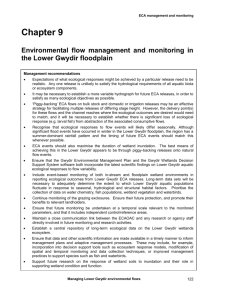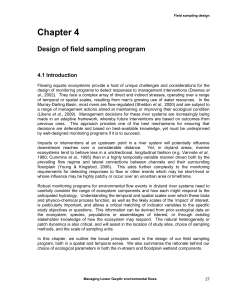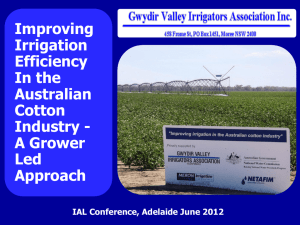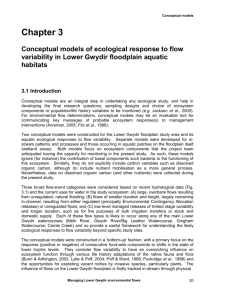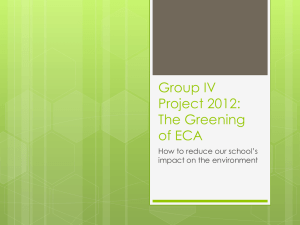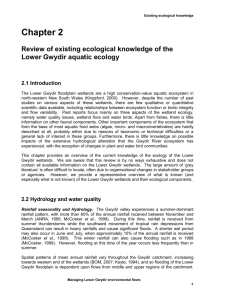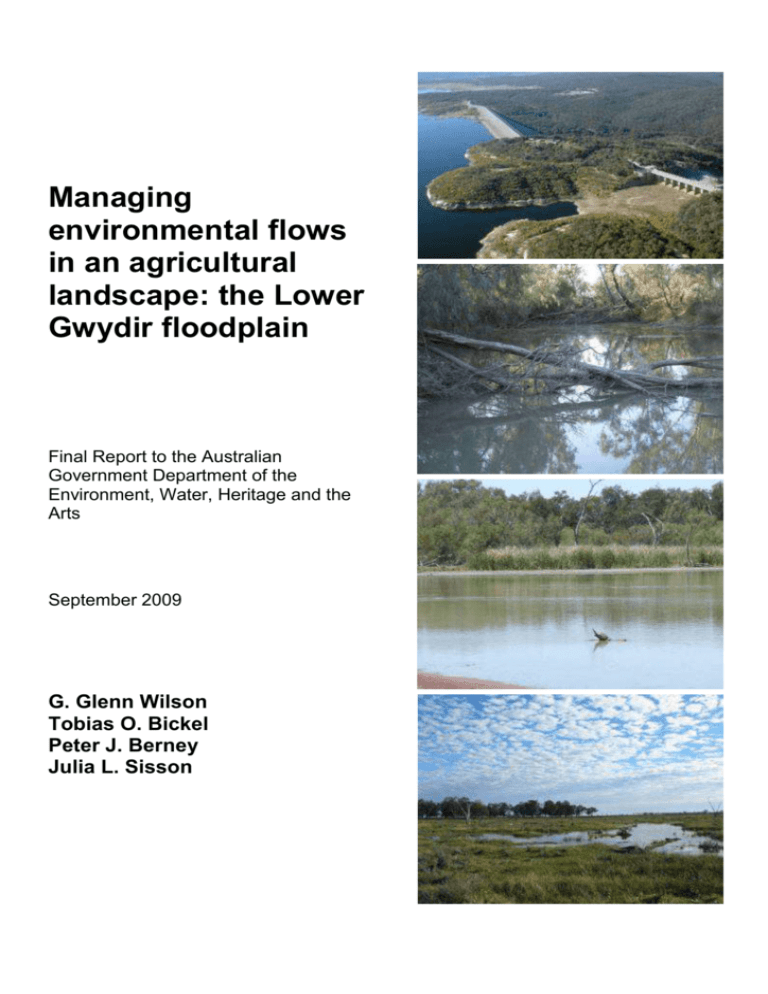
Managing
environmental flows
in an agricultural
landscape: the Lower
Gwydir floodplain
Final Report to the Australian
Government Department of the
Environment, Water, Heritage and the
Arts
September 2009
G. Glenn Wilson
Tobias O. Bickel
Peter J. Berney
Julia L. Sisson
Cover photos
Top: Copeton Dam (Photo: N. Foster); second: Gingham Watercourse at “Willowlee” (Photo: G. Wilson); third: Gingham
Watercourse at “ Boyanga Waterhole” (Photo: G. Wilson); bottom: Gingham floodplain at “Crinolyn” (Photo: P. Berney).
Managing environmental flows in an
agricultural landscape: the Lower
Gwydir floodplain
Final Report to the Australian Government Department of the
Environment, Water, Heritage and the Arts
September 2009
G. Glenn Wilson
Tobias O. Bickel
Peter J. Berney
Julia L. Sisson
Ecosystem Management
School of Environmental and Rural Science
University of New England
Armidale
This report should be cited as:
Wilson, G.G., Bickel, T.O., Berney, P.J. & Sisson, J.L. 2009. Managing environmental flows in an
agricultural landscape: the Lower Gwydir floodplain. Final Report to the Australian Government
Department of the Environment, Water, Heritage and the Arts. University of New England and Cotton
Catchment Communities Cooperative Research Centre, Armidale, New South Wales. 173pp
© University of New England
All rights reserved. This publication is copyright and may not be resold or reproduced in any
manner (except parts thereof for bona fide study purposes in accordance with the Copyright Act)
without prior consent of the publisher.
Dr Glenn Wilson
Ecosystem Management
School of Environmental and Rural Science
University of New England
Ph:
02 6773 3078
Fax:
02 6773 2769
Email: glenn.wilson@une.edu.au
Disclaimer:
The views and opinions expressed in this publication are those of the authors and do not
necessarily reflect those of the Australian Government or the Minister for the Environment,
Heritage and the Arts or the Minister for Climate Change and Water or the Administrative Authority
for Ramsar in Australia.
While reasonable efforts have been made to ensure that the contents of this publication are
factually correct, the Commonwealth does not accept responsibility for the accuracy or
completeness of the contents, and shall not be liable for any loss or damage that may be
occasioned directly or indirectly through the use of, or reliance on, the contents of this publication.
Inundated wetland on “Bunnor” in December 2007, Gingham Watercourse floodplain.
Photo: P. Berney.
i
Contents
Table of Contents
Acknowledgements
vi
Executive summary
vii
Part 1 Introduction, scoping review, conceptual model and field
program design
1
Chapter 1
General Introduction
2
Chapter 2.
Review of existing ecological knowledge of the Lower
Gwydir aquatic ecology
4
2.1 Introduction
4
2.2 Hydrology and water quality
Rainfall seasonality and hydrology
Water quality
Water chemistry
Turbidity and sediments
Nutrients
Pesticides
4
4
5
6
7
7
8
2.3 Algae and in-stream vegetation
8
2.4 Floodplain vegetation
Vegetation patterns
Impacts of flooding and altered flow regime on
wetland vegetation
Impacts of grazing
9
9
10
2.5 Zooplankton and microinvertebrates
13
2.6 Macroinvertebrates
14
2.7 Fish, amphibians and aquatic reptiles
Fish
Fish barriers and passage
Amphibians
Aquatic reptiles
14
14
16
17
18
Conceptual models of ecological response to flow
variability in Lower Gwydir floodplain aquatic habitats
20
3.1 Introduction
20
3.2 In-stream responses
Channel structure
Macrophytes
Invertebrates
Fish
22
22
23
24
24
3.3 Floodplain responses
Physical patch structure
Floodplain vegetation
24
24
25
Chapter 3.
Managing Lower Gwydir environmental flows
12
ii
Contents
Chapter 3 continued
Macrophytes
Invertebrates
Fish
Chapter 4.
Design of field sampling program
27
4.1 Introduction
27
4.2 Choice of study watercourses and spatial sampling design
28
4.3 Temporal sampling design – sampling specific flow events
30
4.4 Choice of response variables
Water chemistry, water quality, algae
Invertebrates
Fish
Wetland plants
31
34
34
34
34
Part 2 Responses of Lower Gwydir wetland and in-stream
environments to flow variability
Chapter 5
Chapter 6
26
26
26
36
Long-term analysis of the effects of inundation and
grazing on vegetation communities in the Gwydir
wetlands
37
5.1 Introduction
37
5.2 Materials and methods
Study sites and inundation history
Vegetation monitoring
Data analyses
38
38
40
41
5.3 Results
43
5.4 Discussion
51
Wetland vegetation responses to recent Environmental
Contingency Allowance releases
54
6.1 Introduction
54
6.2 Materials and methods
ECA hydrology and study sites
Vegetation monitoring
Data analyses
6.3 Results
April 2007 ECA release
Inundation levels
Species richness
Lippia responses to inundation
Water couch responses to inundation
Functional group responses at each site
November 2007 ECA release
Inundation levels
Vegetation response
6.4 Discussion
55
55
56
57
59
59
59
60
61
61
63
68
68
68
71
Managing Lower Gwydir environmental flows
iii
Contents
Chapter 7
Responses of water chemistry, fish and aquatic
invertebrates to flow variability in Lower Gwydir channels
and floodplain waterholes
74
7.1 Introduction
75
7.2 Materials and methods
Sampling sites and timing
Water chemistry
Fish assemblages
Invertebrate assemblages
76
76
76
76
79
7.3 Results
Hydrology
Water chemistry – general and spatial patterns
Water chemistry – temporal patterns
Fish – assemblage composition
Fish – temporal variation in abundances
Fish – spatio-temporal patterns in assemblage
structure
Fish – small-scale assemblage variability
Fish – population size structure
Invertebrates
Temporal variation in macrocrustacean abundances
Spatial variation in macrocrustacean abundances
Benthic microinvertebrates – community composition
Benthic microinvertebrates – spatial and temporal
variation in abundances
79
79
79
82
87
87
93
7.4 Discussion
111
Part 3 Communication, and Management implications
Chapter 8
Chapter 9
93
98
104
106
106
106
106
117
Communication of project findings
118
8.1 Introduction
118
8.2 Industry and community stakeholders
118
8.3 Scientific and management audiences
119
8.4 Lower Gwydir Community Forum
120
Environmental flow management and monitoring
in the Lower Gwydir floodplain
122
9.1 Introduction
123
9.2 Environmental flow design and management
Management tools
123
126
9.3 Monitoring
Spatial and temporal design
Variables
Institutional arrangements
127
127
128
130
9.4 Key areas for future research
Soil ecology
Fish population ecology
Effect of in-stream barriers
Effect of habitat structure on fish assemblages
130
130
131
131
131
References
132
Managing Lower Gwydir environmental flows
iv
Contents
Appendices
140
Appendix 1
Project presentations
141
Appendix 2
Project outputs and conference abstracts
145
Managing Lower Gwydir environmental flows
v
Acknowledgements
Acknowledgements
The present study was funded by the Australian Government, with additional support provided by
the Cotton Catchment Communities Cooperative Research Centre and the University of New
England. The authors particularly thank Gayle Stewart, Bruce Gray and Ian Krebs from the
Australian Government Department of the Environment, Water, Heritage and the Arts (DEWHA),
and Lynda George and Kym Orman from the Cotton CRC, for their assistance with project
administration and reporting, and Ian Krebs and Jennifer Martin (DEWHA) for editorial comments.
No project of this nature can function successfully without the support of landholders on whose
property the field sites are located. We were strongly encouraged by the cheerful willingness of
Lower Gwydir landholders to allow site access, the occasional quad bike loan, assistance with use
of the grazing exclosure sites, accommodation and even the occasional assistance with processing
fish catches:
Bruce and Jen Southeron, “Old Dromana”;
Sam Kirby, “Westholme” ;
Jon Greer, ‘Birrah”;
Guy Murphy, Baroona Waterhole;
Vourn Houlahan, “Talmoi”;
Stuart Boydell, “Weematong”;
Gerry and John Carrigan, “Allambie”; and
Lloyd and Bryce Wood, “Bullarah”;
Howard Blackburn, “Crinolyn”;
Shane Murphy, “Munwonga”;
Rod Fulton-Kennedy, “Willowlee”;
Joe Robinson, “Telleraga”;
Fred Barlow, “Currigundi”;
Phil Flemming and the Murphy family,
“Old Boyanga”.
Numerous colleagues provided invaluable assistance with fieldwork, including Liz Savage and
Jane Humphries (Border Rivers – Gwydir Catchment Management Authority), Jeff Kelleway, Yoshi
Kobayashi and Jennifer Spencer (NSW Department of Environment, Climate Change and Water).
Rob McCosker and John Duggin from Ecosystem Management at the University of New England,
allowed access to past data and information about their wetland vegetation study sites, and Ian
Telford from the Beadle Herbarium at the University of New England provided herbarium space
and materials and assistance with plant identification. Daryl Albertson, NSW Department of
Environment, Climate Change and Water, provided advice on sites, ECA flows and numerous
aerial photos. Members of the Gwydir ECA Operations Advisory Committee also provided useful
advice and helped frame the study in the critical management context.
We also received strong support from colleagues and their organisations with funding and
organising the July 2008 Lower Gwydir Community Forum, particularly Janelle Montgomery and
Lauryn Hanna (NSW Department of Primary Industries), Sara Foot, Ian Schwartz, Tariful Islam,
Louise McMahon and Liz Savage (Border Rivers – Gwydir Catchment Management Authority), Neil
Saintilan (NSW Department of Environment, Climate Change and Water) , Richard Moxham and
Donna Ironfield (Murray-Darling Basin Authority), David Aber and Mike Montgomery (Moree Plains
Shire Council), Paula Jones (Cotton Catchment Communities CRC), and James Houlahan and
Michael Murray (Gwydir Valley Irrigators Association).
The various steering committee members and their organisations are also thanked for their support
of the study, attendance at committee meetings, and feedback on project progress and outputs:
Gayle Stewart, Bruce Gray and Ian Krebs, DEWHA;
Michael Murray, Gwydir Valley Irrigators Association;
Jim Southeron, Lower Gwydir Water Users;
Paula Jones, Cotton Catchment Communities Cooperative Research Centre;
Liz Savage, Border Rivers – Gwydir Catchment Management Authority;
David Ward, NSW Department of Primary Industries;
Yoshi Kobayashi, NSW Department of Environment, Climate Change and Water;
Neal Foster, NSW Department of Water and Energy; and
Darren Ryder, University of New England.
Managing Lower Gwydir environmental flows
vi
Executive summary
Executive summary
The Lower Gwydir floodplain is recognised for its high-conservation value as aquatic plant
and wildlife habitat. This, along with the significance of the terminal wetland areas for water
bird breeding, has resulted in parts of the floodplain being included, in the late 1990s, on the
List of Wetlands of International Importance under the Ramsar Convention on Wetlands.
However, construction of Copeton Dam upstream in the mid 1970s and subsequent changes
to the region’s irrigation, grazing and cropping industries has altered flow patterns into the
wetlands and placed other pressures on the wetlands and their biodiversity values. The
Gwydir Regulated River Water Sharing Plan was developed in the early 2000s, in part to
counter further wetland degradation and to establish an allocation balance between
consumptive and environmental needs. A broad stakeholder committee (the Gwydir
Environmental Contingency Allowance Operations Advisory Committee; ECAOAC), currently
administered through the NSW Department of Environment, Climate Change and Water, is
the primary mechanism by which the subsequent flow allowance is used for environmental
benefit. It is the overarching aim of the present study to determine the ecological responses
to flow variability in the Lower Gwydir aquatic ecosystem, and to provide the ECAOAC with a
model to guide the effective management of flows to maximise ecological responses in this
system. The listing of wetlands on “Old Dromana”, “Crinolyn”, “Goddard’s Lease” and
“Windella” with the Ramsar Convention will continue to be a major driver of delivering
environmental flows into the Lower Gwydir floodplain.
Objective 1. To determine the flow requirements of streams and terminal wetlands on
the Lower Gwydir floodplain
A review of the availability of existing aquatic ecological knowledge on the Lower Gwydir
floodplain revealed relatively few data specific to this ecosystem. Most available information
focused on water quality and chemical parameters, the fish and macroinvertebrate
assemblages and the responses of floodplain wetland vegetation to inundation and grazing.
The construction of Copeton Dam was identified as having had profound impacts on
hydrological patterns in the Gwydir floodplain, with a significant reduction in flood frequency,
duration and extent. Even though water quality parameters have improved considerably over
the last decade, ANZECC guidelines are still frequently breached. Increases in water
turbidity and nutrient levels are linked to flow events.
There is little knowledge on algal and in-stream vegetation along Lower Gwydir watercourses.
The high turbidity probably restricts algal and macrophyte growth to shallow areas and
suitable substrate. However, the Lower Gwydir floodplain wetlands are a highly significant
wetland habitat for NSW and the northern Murray-Darling Basin.
Their vegetation
communities are closely linked to inundation patterns, with distinct plant communities being
associated with the area’s flood history. Nevertheless, the floodplain vegetation has changed
profoundly since development of Copeton Dam, and additional grazing pressure also impacts
the response of native wetland vegetation following inundation. Core wetland areal extent is
thought to have declined by around 90%.
Managing Lower Gwydir environmental flows
vii
Executive summary
Micro- and macroinvertebrates are an important component of aquatic ecosystems, although
most available knowledge of these assemblages for the Lower Gwydir is limited to a
comparison with similar river systems in the Murray-Darling system and several egg-bank
emergence experiments. Gwydir wetlands support up to 500 macroinvertebrate species and
the microinvertebrate community is comparable to other temporal wetlands in the MurrayDarling basin. The Lower Gwydir watercourses also contain at least nine native fishes, some
of which are rare or endangered and of strong angling interest, and three exotic species.
Changes in flow regime are thought to have been detrimental to the region’s native fishes but
may have favoured the exotic species. Additionally, weirs and rock crossings are a common
feature in the Lower Gwydir catchment and are thought to restrict the movement of native
fish, particularly upstream. The Lower Gwydir wetlands are also home to a species-rich frog
community and aquatic reptiles such as turtles and the Murray-Darling carpet snake.
Conceptual models are important tools for scientific ecological studies, assisting with the
development of research questions and guiding the choice of ecosystem components that
need to be monitored. We constructed two separate conceptual models for in-stream and
floodplain responses to flow variability to help better predict the ecological responses to flow
events in the study system and to assist in the choice of ecological response variables in the
field component of the study.
Three ECA releases occurred during the project interval, in December 2006, April 2007 and
November 2007, with the objective of wetting core wetland areas. All fieldwork from October
2006 to February 2009 was timed to allow sampling before and after these releases. Instream ecosystem components were sampled on eleven occasions, from October 2006 to
February 2009, in the Gingham Watercourse and Gwydir and Mehi rivers, while monitoring of
the response of vegetation in nearby floodplain wetlands to ECA events was undertaken on
seven occasions from March 2007 to April 2008. Other analyses of long-term vegetation
responses to flows and herbivore grazing utilised data from a series of grazing exclosure
sites, established in 1994. Some monitoring was also undertaken in a series of floodplain
lagoons to the north of the Gingham Watercourse.
The responses of wetland vegetation to inundation were first examined alongside the effects
of herbivore grazing using data collected from May 1994 to March 2008. Inundation was
found to have the greater influence on the dynamics of the wetland plant communities, and
grazing was found to affect plant communities in different ways depending on the dominant
plant species and antecedent soil-moisture conditions. In marsh club-rush communities,
grazing resulted in a break-down of the dense canopy formed by this tall species. As a
consequence, more light reached the ground and a range of other native species such as
swamp buttercup and knotweeds could grow. However, in water-couch communities, grazing
helped to maintain the dominance of this species by removing taller herbaceous species that
shade the water-couch.
The response of vegetation to flooding from individual ECA releases varied markedly
depending on the season of release. The vigour of the response was far higher in summer,
the time of the year when native perennial species are growing actively. Native species then
successfully competed with the invasive weed lippia, leading to a reduction in lippia cover
following the flow. Following an autumn release, the initial growth of key species such as
water couch was halted with the onset of winter frosts. Seasonal conditions, combined with
grazing of the previously flooded sites, meant that few benefits of the ECA release were
evident at the beginning of the following spring.
Managing Lower Gwydir environmental flows
viii
Executive summary
We measured a range of water chemistry parameters in the Lower Gwydir waterways. Our
samples showed that the overall water quality was poor in the three waterways, with high
nutrient and sediment loads. Flow releases for both ECA and other purposes either reduced
nutrient concentrations through a dilution effect or increased concentrations. Additionally,
given the higher discharge levels during releases, actual nutrient and sediment loads
increased during flow events even when apparent nutrient concentrations were diluted by
higher discharge.
We found a total of twelve freshwater fishes in the Lower Gwydir watercourses, 3 of which
were exotic species. The fish community was dominated by only a few species (bony bream,
spangled perch and carp gudgeon), while most other species were only caught in low
numbers. European carp was the most common exotic species, dominating the fish
assemblage from a biomass perspective. There was a change in fish assemblages along an
upstream-downstream gradient, with many of the less-common native species occurring
predominantly in upstream sites on the three watercourses. This pattern was especially
pronounced in the Gingham Watercourse.
The variable hydrograph and the timing of multiple flow events in each season made it
difficult to distinguish flow responses from seasonal variability in fish communities.
Recruitment was observed in spangled perch, bony bream, carp gudgeon, and carp, while
smaller numbers of juvenile smelt, un-specked hardyhead, and goldfish were also observed.
Juveniles of other taxa such as golden perch, eel-tailed catfish, and Murray cod were present
only in low abundances. Pulsed flow events (including ECA releases) did not result in a
consistent response of fish assemblages, and responses varied between rivers and seasons.
The lack of a clear response of fishes to flow releases suggests that factors other than recent
hydrology may be determining fish assemblages in Lower Gwydir waterways. The lack of a
clear response of Lower Gwydir fish assemblages to the ECA flow events may reflect a less
important role of minor flow events on fish recruitment in these river systems or may in part
reflect the hydrological characteristics of recent ECA releases.
The benthic invertebrate community comprised over 70 taxa, with rotifers and microcrustacea
being the most speciose groups. At the temporal scale of our sampling, flow variability
appeared to only explain part of the variation in the invertebrate community composition of
the Lower Gwydir River. Similar to fish, we could not detect a consistent response to flow
releases in macrocrustacean (shrimp and yabby) abundances, and both temporal and spatial
abundances did vary widely between the three study channels.
Management recommendations
Delay grazing or maintain low stocking rates during the initial stage of wetland flooding to allow
fragile plant species in the amphibious responder functional group to flower and set seed.
Maintain conservative cattle stocking rates (0.3-0.5 animals per hectare) to protect key native
species from over grazing.
The spatial extent of impact of an ECA flow on wetland vegetation and the duration of flooding
are likely to be maximised when ECA releases follow a natural flood event.
Continue to include event-based vegetation monitoring in any reporting of ecological outcomes
from Lower Gwydir ECA releases. Include the four sets of grazing-exclosure plots in this
schedule. Future monitoring of vegetation responses to ECA flows should include quantifying
changes in biomass as well as percent foliar cover.
Include event-based in-stream monitoring in relation to reporting ecological outcomes from
future Lower Gwydir ECA releases.
Managing Lower Gwydir environmental flows
ix
Executive summary
Recognise that ecological responses to flow events will likely differ seasonally. Although
significant flood events have occurred in winter in the Lower Gwydir floodplain, the region has a
summer-dominant rainfall pattern and the timing of future ECA events should match this
whenever possible.
Objective 2. To develop recommendations for future flow management, monitoring
indicators, and institutional arrangements for the Lower Gwydir aquatic ecosystem
ECA releases throughout the study period were of a limited and relatively stable stage height,
designed to deliver the volume anticipated necessary to inundate the core wetland and to
minimise losses onto the floodplain upstream of the target area(s). This may have limited the
in-channel responses of some water chemistry parameters and faunal assemblages.
Expectations of what ecological responses might be achieved by future ECA releases into the
Lower Gwydir floodplain will need to be realistic. It may be necessary to consider a multirelease program to satisfy as many ecological objectives as possible. ‘Piggy-backing’ ECA
flows on transfers for stock and domestic or irrigation purposes might be an effective strategy
for facilitating multiple releases of differing stage height. Where an ECA release is made to
benefit core wetland areas, attempts should be made to maximise the duration of floodplain
inundation. Again, the best means of achieving this in the Lower Gwydir appears to be
through piggy-backing releases onto natural flow events.
The variable nature of dryland river ecology means that data sets longer than the present 3year study will be essential if we are to fully appreciate the responses of the Lower Gwydir
ecosystem to managed releases or flow variability more generally. Future monitoring should
include measurement of responses to individual ECA events, but also provide data from a
longer sequence of varying seasonal and discharge conditions. Such a program should be
structured in an event-based way but also allow for monitoring of low-flow and winter periods
away from the usual spring-summer interval of higher flows. It will be critical that any future
monitoring program be able to account for likely differences in temporal scale of response
among biotic or other variables, as not all responses will be adequately detected by a single
monitoring sequence. It may be necessary to monitor different variables at varying temporal
scales, from days to weeks or months following the onset of a flow event. It will also be
necessary to include a careful array of reference/control sites away from the target of any
future ECA flows.
It is recommended that monitoring of the present suite of water chemistry parameters be
continued. As wetland vegetation seems likely to remain a key ecological objective for ECA
releases, future Lower Gwydir monitoring should include these assemblages and the series
of UNE grazing-exclusion plots. In addition, it is recommended that further investigations
examine the impact of flooding frequency on soil condition and the response of floodplain
soils to wetting and drying, and to establish monitoring protocols for soil chemistry and
biology. While we also recommend monitoring of fish be continued in Lower Gwydir
channels, it is vital that this facilitate a stronger understanding of the lifehistory of key fishes
within the Lower Gwydir ecosystem and we suggest that monitoring include responses such
as spawning activity. The effect of in-stream barriers on Lower Gwydir fish assemblages also
needs to be established.
In order to maintain the current momentum of research on the Lower Gwydir aquatic ecology,
and to meet the invariable longer-term requirements of any monitoring program, we
recommended that formal collaborative partnership arrangements be established between
Managing Lower Gwydir environmental flows
x
Executive summary
research organisations and management agencies. There also remains a clear need to
establish a repository of long-term ecological data on the Lower Gwydir aquatic ecosystem.
Management recommendations
Expectations of what ecological responses might be achieved by a particular release need to be
realistic. Any one release is unlikely to satisfy the hydrological requirements of all aquatic biota
or ecosystem components.
It may be necessary to establish a more variable hydrograph for ECA releases, in order to
satisfy as many ecological objectives as possible.
‘Piggy-backing’ ECA flows on bulk releases for stock and domestic or irrigation purposes may
be an effective strategy for facilitating multiple releases of differing stage height. However, the
delivery point(s) for these flows and the channel reaches where the ecological outcomes are
desired would need to match. Moreover, it will be necessary to establish whether there is
significant loss of ecological responses (e.g. larval fish) through abstraction of the associated
consumptive flows.
Recognise that ecological responses to flow events will likely differ seasonally. Although
significant flood events have occurred in winter in the Lower Gwydir floodplain, the region has a
summer-dominant rainfall pattern and the timing of future ECA events should match this
whenever possible.
ECA events should also maximise the duration of wetland inundation. The best means of
achieving this in the Lower Gwydir appears to be through piggy-backing releases onto natural
flow events.
Continue to include event-based monitoring of both in-stream and floodplain wetland
environments in relation to reporting ecological outcomes from Lower Gwydir ECA releases.
Long-term data sets will be necessary to adequately determine the extent to which Lower
Gwydir aquatic populations fluctuate in response to seasonal, hydrological and structural habitat
factors. Prioritise the collection of data on water chemistry, fish populations, wetland vegetation
and waterbird assemblages.
Continue monitoring of the grazing exclosures, and promote their protection and benefits to
relevant landholders.
Ensure that future monitoring be undertaken at a temporal scale relevant to the monitored
parameters, and that it includes independent control areas.
Ensure close communication between the ECAOAC and any research or agency staff directly
involved in future monitoring and research activities.
Establish a central repository of long-term ecological data on the Lower Gwydir wetlands
ecosystem.
Ensure that data and other scientific information is made available in a timely manner to inform
management plans and adaptive management processes. This may include, for example,
incorporation into decision support tools such as ecosystem response models, modification of
spatial and temporal monitoring and data collection techniques, or improved management
practices to support species such as fish and waterbirds.
Support future research on the response of wetland soils to inundation and their role in
supporting wetland condition and function.
Support future research on the population ecology of fish, particularly the effect of flow variability
on early growth and body condition.
Establish the effects of in-stream barriers on Lower Gwydir fish assemblages.
Establish whether Lower Gwydir fish assemblages vary with structural habitat within and
between channels.
Managing Lower Gwydir environmental flows
xi
40
35
Executive summary
25
20
15
10
Maximum
Minimum
Objective 3. To provide managers of the Gwydir Regulated River ECA and other river
flows into floodplain terminal wetlands with a model guiding the effective management
of flows to maximise environmental outcomes
5
0
During the study interval, ECA80 releases were made during spring-summer and late autumn,
and we summarised anticipated responses of fish and wetland/floodplain vegetation to
releases in these two broad 60periods. Spring-summer releases are expected to generally
produce greater cover of amphibious plants and flowering and seed setting, although reduced
cover of terrestrial species. Some amphibious species may partially outcompete weed
40
species such as lippia. Releases
during this time would be expected to produce a moderate
to strong recruitment response in a range of fish species, although this may include European
20
carp. By contrast, releases during
autumn to early winter are expected to produced more
limited increases in the cover of amphibious plants although without significant flowering or
seed setting. Fish recruitment
responses are also likely to be limited at this time of year.
0
Oct
Nov
Dec
Jan
Feb
Mar
Apr
Terrestrial
plant
species
are
likely
to benefit more from releases in autumn-winter than in
Month
spring-summer.
Rainfall (mm)
Temperature (oC)
30
Sep
This information should be considered in the finalisation and implementation of the Gwydir
Wetlands Adaptive Environmental Management Plan and Gwydir Wetlands Decision Support
System.
Management recommendations
Take seasonal differences in ecological response to flow events into account when planning
annual ECA release schedules.
Ensure that the Gwydir Environmental Management Plan and the Gwydir Wetlands Decision
Support System software both incorporate the latest scientific findings on Lower Gwydir aquatic
ecological responses to flow variability.
Managing Lower Gwydir environmental flows
xii

